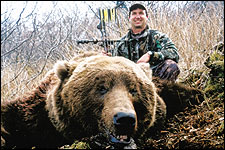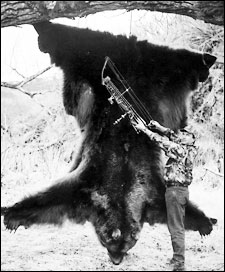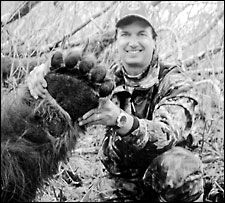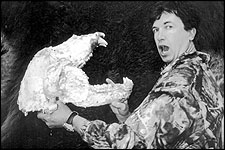October 28, 2010
By Bob Fromme
A long-dreamed-of hunt for one of Kodiak Island's oversized bruins becomes a quest of record proportions.
By Bob Fromme
 Bob Fromme with the world-class Alaskan brown bear he took last May on Kodiak Island's Dead Man's Bay. |
Like most addicted archery hunters, I always feel there is too much time and too much work between hunts. Living vicariously through other people's magazine articles and video footage may temporarily satiate my appetite, but it also seems to intensify my desire to participate. I have a list of dream hunts, most dependant on minuscule odds of drawing a coveted tag, but by midsummer, the mailman has usually doused all glimmers of hope. Other hunts require large sums of cash. It takes a lot of empty beer cans to finance a brown bear, desert sheep or polar bear hunt. If you plan properly and are dedicated, many of your dreams can become reality. It just may take longer for those of us with average incomes to realize them.
In January of this year I got a call from Tom Kirstien notifying me that he had an opening in May on Kodiak Island, which is synonymous with gargantuan brown bear, and lots of them. I have known several hunters who have hunted with Tom, and they have taken excellent bears with their bows. In 15 days of hunting I could expect to see between 75 and 100 bears; these were odds I liked. All the main criteria for a successful hunt were falling together--lots of opportunity, high trophy quality, an outfitter who can get it done for a bowhunter and the right time slot for most of the bears to be out of hibernation. The only thing holding me back was the same hurdle I had trouble getting over five years ago when I first contacted Tom: money, and lots of it.
Advertisement
I had already been on several caribou and moose combo hunts where a trophy fee would be charged if I took a griz. After three such hunts and no shot opportunities at bears, I booked a mountain grizzly hunt in British Columbia in a great area where a grizzly was the primary target. You guessed it; I shot a griz. I had already spent enough money on the three previous combo hunts to do it right on Kodiak. There were no guarantees on this hunt, but the odds of taking a bear were sure better than on the combo hunts. I didn't have anything else major booked for the fall, and by adding a little more to my hunt fund, I figured I could make it happen.
Kodiak has about 5,000 square miles of landmass, which supports approximately 5,000 of the big brownies. A long growing season, good genetics and rivers teaming with protein in the form of salmon are several good reasons why the bears of Kodiak are legendary for their size. Grizzlies don't mix well with people and need lots of wilderness to roam about. The scant 90 miles of road system is focused around the city of Kodiak, a hamlet with a population of about 10,000. Kodiak also sports one of the U.S.'s largest fishing fleets. The cold, nutrient-rich waters abound with halibut, cod, salmon, crab, shrimp and shellfish. The most widely hunted big game animal on the island, by far, is Sitka black tail deer, which I hunted in 1996. In six days of hunting, I filled four tags with Pope & Young-scoring bucks, took a fox and was amazed by the experience that is Kodiak. I couldn't wait to get back. I hoped some day that I would be able to pursue the big bears that rule the mountains and patrol the shorelines.
Advertisement
 Fromme's giant brown bear squared 10 feet, 4.5 inches, tipping the scales at more than 1,000 pounds, even though the big boar had only recently emerged from its winter den. Fromme used a 74-pound bow and a carbon arrow tipped with a fixed-blade broadhead. |
There's something about grizzly hunts and sheep hunts that stimulate me to prepare earlier and harder than usual. I guess it's the urgency of making the best of whatever limited opportunities might arise. Then add the dangerousness of the bear, add a cameraman to record your actions for all to see and the pressure to perform magnifies. I strongly believe what you do before the hunt has a huge effect on its outcome. Luck is where preparation and opportunity come together.
Between competitive tennis, ocean kayak fishing, mountain biking, moderate weight training and year-round hog hunting, I'm usually not too far off physically. I usually throw in some extra bike and stair work for an added edge. My shooting also gets extra attention with focus on correct form and consistent repetition--30 to 50 arrows per session, four to five times each week. You can over-practice. I find that taking a few days off when you are really not into it is better than programming your subconscious to believe you are capable of second-rate shots or worse.
You don't have control over the weather or what the animals will do--you can only go by past history--but you do have control over your equipment. Owning a pro shop makes me a perfectionist when it comes to gear and having it tuned right. Paying attention to small details makes a difference. There's lots of great equipment to choose from. I chose a compound set at 74 lbs., flipper rest to match my finger-shooting style, the best bow-silencing accessories (when you're 18 yards from a griz, your bow can't be too quiet), carbon/aluminum arrows and a three-blade, fixed broadhead. All bears have great noses, so my clothing included scent-eliminating clothing incorporated with great raingear. My optics were meant for every and any weather condition. Footwear was a challenge because lots of walking and water crossings would be the norm. Tom recommended neoprene hip waders with fly-fishing wading shoes over them. I opted for hiking boots for ankle support.
It wasn't long before I met up with Jerry Morrison, my cameraman. Besides being great with a camera, Jerry is a very accomplished bowhunter, so I knew he wouldn't blow any opportunities I might get. The main reason I wanted him on the hunt was for bear diversion. I know I can outrun Jerry but only because he is 60. He's still lean and mean enough to get around the hills, and his jovial sense of humor is nonstop.
Conditions on Kodiak were bang-on at our arrival. The heavy snowpack in the higher elevations was receding rapidly; bear activity was really starting to pop. Tom had a spot in mind for our first day. After a short ride in the skiff, we scaled a small mountain to a vantage point that gave us a commanding view of a prime denning basin. It wasn't long before we were spotting bears. Out of the 10 bears we spotted, two appeared to be in that 10-foot category. I told Tom I wanted a really big bear, but due to the magnitude and cost of this hunt, any 9.5-foot boars in the right place would warrant a stalk. On Kodiak there is always a chance of running into a world-record bear, but I didn't think I could wade through big bears long enough to get to a monster of Jurassic proportions.
One of the big boars we spotted started ambling down from the snow-covered peaks to nibble on the fresh, tender grasses that were poking up at the lower elevations. We were watching his progress, hoping for a run at him if he slowed down, when suddenly his back end stumbled. That's when the delayed thunder of a high-powered rifle broke the silence. Eight to 10 shots later, all was quiet again. We were all stunned. There are several resident tags for this area, and Tom wasn't aware that anyone had flown in. Our hotspot was tainted, at least for a few days. There was plenty of other great country to scan with our glasses.
That morning, on our way out across the bay, Tom had noticed the track of a large bruin plowing through the snow pack and heading toward the beach on the opposite side of Dead Man's Bay. We decided that this was where we would focus our attention for the remainder of that first day. Again, it didn't take long to identify the dark-brown outline of our intended quarry. The bear was low, feeding slowly and appeared to be huge--how huge we were about to find out.
 It takes two hands to shake this guy's mit. The big boar was so fresh out of hibernation that the hair on its giant paw pads hadn't had time to wear off yet. |
Days on Kodiak begin to get long in May. Tom figured we would have until about 10 p.m. to get our task done. The time was 8:30 p.m. We put the skiff in stealth mode and continued on our quest. We landed well downwind of the last spot we has seen the bear and talked over some strategy. We wanted to wait and see if the bear might show itself on the beach. My instinct was to follow the worn trail he used and catch him grazing in one of the small grassy patches that dotted the lower alder jungle.
We hadn't gone far when our bear was spotted. He got a little glimpse of us at about the same time, though he hadn't seen enough to identify us as humans. With elk I'll cow call, with deer I'll grunt, with the bear the only sound I could think of that might make him think we were another bear was a growl. I really hoped the sound might calm him down. At my imitation he stopped, nibbled on some grass and lay down. We were at 65 yards, and he was facing us.
I whispered to Tom that we needed to let him settle down and not move for 15 minutes, and then I would take off my boots and crawl very slowly, hopefully to 40 yards or less. Tom never told me how big he thought the bear was, but when you see something of this magnitude, words are unnecessary.
As I approached, if I even thought the bear was going to pick up his head, I stopped all movement. Everything was almost perfect; the wind was right, the approach was quiet, a stream was rushing over rocks not far from the bear, my low profile and camo clothing blended with the vegetation. On the downside, we were running out of light and I was on the wrong side of the animal. A head-on bow shot on a bedded brown bear doesn't display good survival instincts in the shooter.
My goal was to get a clear shot at 40 yards. Constantly ranging the bear as my stalk progressed, I squared up for the shot when the 40-yard digital readout appeared. I motioned with my hand for Tom to blow his varmint call, hoping to get the bear up without focusing attention on me. At Tom's call, he raised his massive head then rolled over on his side. For the first time during the stalk, my position was out of the bear's line of sight.
 The author with the skull of the monster, scoring 28 8/16 unofficially. A drying-out period and subsequent scoring will have to be done before the bear's measurements becomes official, but at the time this issue went to press it was clear the animal would rank among the best in the record book. |
Intending to quickly seize the moment, I rose to my feet and tip-toed behind one of the world's largest carnivores. As I edged ever closer, paying great attention to my path and his head, the thought crossed my mind that he might be letting dinner come to him, kind of a home-delivery. Twenty-five yards and closing. The way the cover laid out, I needed to close to 20 yards to get the angle I needed. At 18 yards, I stood in the optimum place without blocking his escape route into the alders. Tom didn't like the position he held with his backup rifle, but he knew I was ready to strike.
Tom took a few steps forward in case he needed to save my rear. The big boy caught the movement, rising up on his front legs and exposing a perfect triangle in his armpit. I remember drawing smoothly, all the while telling myself to steady the pin and everything else would be automatic. Being that close, the arrow flight seemed instantaneous, the nock appearing to slow down as the broadhead fully penetrated the big boar's vitals, protruding through the off shoulder. He snarled, bit his side and angled toward me on a death run.
I could tell the boar wasn't looking at me, so remaining still seemed like a good thing to do. The monster bear passed by at 10 yards, and I could tell he wasn't going much farther. I saw him go down. The stalk was patient, the shot true, the kill quick, the feeling of accomplishment indescribable.
Tom and Jerry ran up to me, hooting and hollering. This is when Tom told me that the bear could be a world record. Sometimes your dreams do come true.
Editor's note: Bob's bear squared 10-feet, 4 1⁄2 inches and weighed more than 1,000 pounds. In the fall he would have weighed about 1,400 pounds. The green score by a qualified measurer is 28 8⁄16, just slightly larger than the official world record. Bear skulls don't shrink much; the score may stick, it may tie or it may fall somewhere down the list. Fred Bear's famous brown bear currently stands as number two at an even 28 inches. Regardless of where the bear finally ranks, this is an outstanding animal.
